While philosophers and critics debate the meaning, purpose and aesthetics of art, naïve art, a genre whose time has come, persists in capturing audiences’ attention. Why is that?
Well, for one thing, successful art engages the viewer, connects with the eye, the brain and the heart. Shea Hembrey, artist and curator, frames this a bit differently, in a recent TED TALK, “How I became 100 artists”. For him art must have a worthy concept behind it (Head), reflect high standards of craftsmanship (Hands) and convey an emotional impact (Heart). He also uses his “Mimaw” test which goes like this. If he cannot explain a piece of artwork to his grandmother in five minutes or less then it is either overly obscure, obtuse or not worth the effort. A visit to GINA Gallery (www.ginagallery.com) will convince you that naïve art is worthy of your attention by any of these standards/criteria. Let’s see why.
International naïve artists score high on craftsmanship. Largely self-taught, their canvases are typically a riot of color and detail. Each leaf, flower, reflection or moonbeam, contrasting texture or atmospheric humidity is rendered with expertise and exacting precision. Don’t take our word for it, though. Sample the variety of offerings from 32 different countries displayed at GINA Gallery.com. The level of craftsmanship and artistry, self taught though these artists may be, won’t disappoint.
Color, composition and detail make a decorative and pleasing painting but what about the “Head”, the concept? What is it about this genre that connects not only with the eye but with the intellect? Eduardo Ungar, from Argentina is a naïve artist who makes us think. Morning is a good example. What do we see here? Layer upon layer of human interaction with people, architecture, time and space that force us to engage and to wonder.
In this scene we have two different spaces. The hall of the building and a children’s clothing shop that we can peek into from the street. Outside the shop on the street is a mother and child in a carriage that has attracted the attention of an older man.The man on the ladder cleans the mirror high in the rose window in which we see reflected a young woman seeming to hurry along with a bag over her shoulder. Simultaneously a housewife enters the building traversing the black and white tiled floor. Outside at the curb waits our pensive motor cyclist, hand on chin and helmet. A moment in time encompassing four different spaces has been compressed onto a canvas 88 cm by 66 cm. Why does this “work”? For one thing Ungar piques our curiosity about what is going on. This slice of life narrative asks: Who is the cyclist waiting for and where is he headed? Could the image of the girl in the glass be the object of his affection? Does his gesture signify impatience or dreamy reverie? What awaits the Signora at the end of the lobby? A mundane scene or an intimate screen shot with a story behind every character?
Urban street scenes of Argentina are replaced by the countryside where a middle class couple of a bygone era sits in a bucolic setting to enjoy a picnic. Reminding us somewhat of Manet’s Dejeuner sur l’Herb, this scene by itself is incomplete for Jean –Pierre Lorand of Belgium, who makes us pay more close attention by including a watchful bear standing on hind legs looking a bit like the “Smokey the Bear” icon of Forrest Ranger fame, and a graceful white tailed fox on the right. Do the pair of pigeons on the branch echo the togetherness of the couple on the grass preparing to enjoy their light repast? And what of the title, “A Feast for the Eyes”? Exactly who are feasting or becoming the feast in this story? Here whimsy and humor capture the audience with a language that is both precise yet also symbolic. We are invited to speculate about what will happen next in this story.
Home-Made Sweets,, by Ana Maria Diaz , on the other hand, paints an idealized and charming picture of her childhood village in Brazil and an elderly lady distributing goodies to the village children. Joop Plasmeyer of the Netherlands transfixes us with his rich palette of blues and arresting red boat in his painting of Delft Harbor, Rotterdam (see below). But these paintings, while decorative make unexpected connections with the audience. Here the depth of dialogue with the audience is the result of each painting’s accessibility and the chord that it strikes deep within us. Perhaps we have visited a similar place or shared a comparable memory. In these examples, it is the viewer who contributes his experiences to the emotional mix, and in the process becomes partners with the naïve artist who, in recreating his or her world, makes a space within it for the audience.
These nostalgic images of festive family meals, hearthside gatherings, workers in the field, circuses, harvests, kite flying or school yard playgrounds are the grist of the naïve artist. While some canvases are rendered with certain intellectual appeal, they always come with an invitation to the audience to partake of the “offering.” Without fail, their bright colors, childlike composition, limited perspective and emotional punch woo us with their whimsy, humor, beauty, cultural diversity and deft technique that succeed in recreating the lacy fabric of curtains framing a window, golden sheaves of wheat drying in the fields, cascading waterfalls or the antics and grace of beloved pet cats that can transform a dwelling into a home.
Come and discover the world of naïve art and why it appeals to you. GINA Gallery invites you to visit us at GINA Gallery.com and Facebook.com/GINAGallery. We are confident that many of these joyful works will find a place in your heart, and will be delighted to assist you in finding them a place in your home.


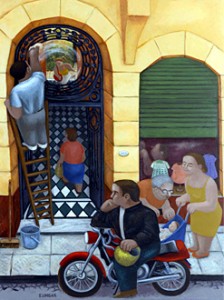
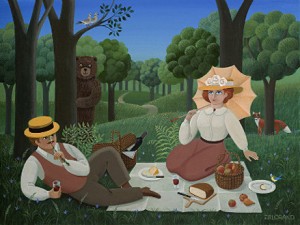
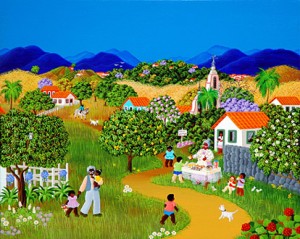
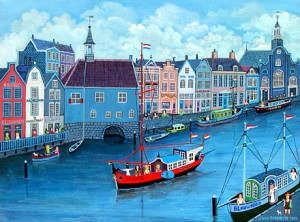
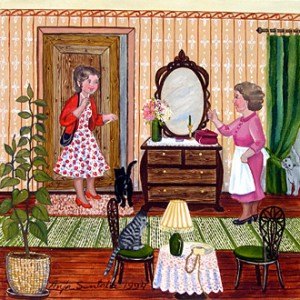
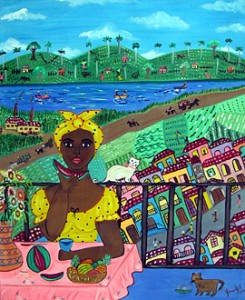
I simply want to tell you that I am new to blogging and truly enjoyed your web page. Likely I’m going to bookmark your blog . You really have amazing writings. Many thanks for sharing your website.
Thanks so much for your comment. We are happy that you enjoyed the first few postings on the GINA Gallery Art Blog. A new exhibition is opening on January 12 entitled Nature Inside Out that features the best of the Argentinian and Brazilian contemporary naives. I hope that we will have a posting about it up soon. Meanwhile you can visit the GINA Gallery web site at http://www.ginagallery.com and view the paintings from these countries.